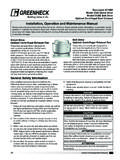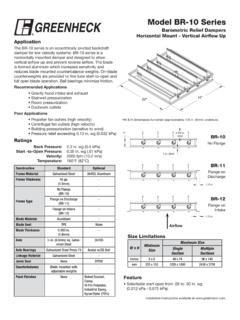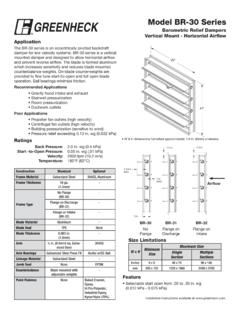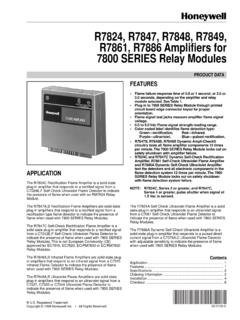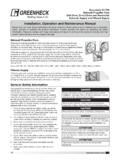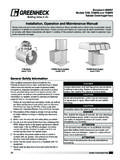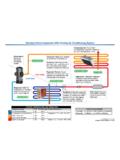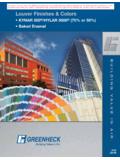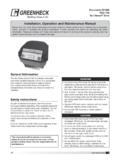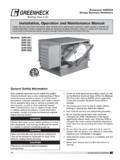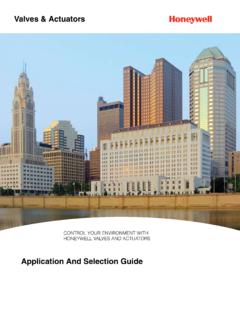Transcription of Fan Application product application guide - …
1 Fan Application . FA/102-99. product Application guide A technical bulletin for engineers, contractors and students in the air movement and control industry. Understanding Temperature and Altitude Corrections The most common influences on air density are the 1. Using the chart, the correction factor is effects of temperature other than 70 F and 2. Multiply the specified operating static barometric pressures other than caused by pressure by the correction factor to determine elevations above sea level. the standard air density equivalent static pressure. (Corrected static pressure = in. Ratings found in fan performance tables and curves wg x = 6 in. wg. The fan must be selected are based on standard air. Standard air is defined as for 6 in. of static pressure.). clean, dry air with a density of .075 pounds per 3. Based upon our performance table for a cubic foot, with the barometric pressure at sea level 20-BISW fan at 5,000 cfm at 6 in.
2 Wg of inches of mercury and a temperature of 2,018 frpm is needed to produce the required 70 F. Selecting a fan to operate at conditions other performance. (This now requires a Class II. than standard air requires adjustment to both static fan. Before the correction was made it would pressure and brake horsepower. The volume of air have appeared to be a Class I selection.). will not be effected in a given system because a fan 4. The bhp from the performance chart is will move the same amount of air regardless of the 5. What is the operating bhp at 600 F? air density. In other words, if a fan will move 3,000. cfm at 70 F it will also move 3,000 cfm at 250 F. Since the horsepower shown in the performance Since 250 F air weighs only 34% of 70 F air, the fan chart refers to standard air density, this should be will require less bhp but also create less pressure corrected to reflect actual bhp at the lighter than specified. operating air.
3 Operating bhp = standard bhp or = bhp. When a fan is specified for given cfm and static pressure (Ps) at conditions other than standard, the Important: We now know the operating bhp. correction factors (shown in table) must be applied However, what motor horsepower should be in order to select the proper size fan, fan speed and specified for this fan? bhp to meet the new condition. The best way to understand how the correction factors are used is to work out several examples. Let's look at an example using a specification for a fan to operate at 600 F at sea level. This example will clearly show that the fan must be selected to handle a much greater static pressure than specified. Example #1: A 20 inch centrifugal fan (20-BISW) is required to deliver 5,000 cfm at inches static pressure. Elevation is 0 (sea level). Temperature is 600 F. Note: It's acceptable to interpolate when exact temperatures or elevations are not shown in chart.
4 Box 410 Schofield, WI 54476 Fax Copyright 2005 Greenheck Fan Corp. Greenheck product Application guide If a fan is selected to operate at high temperatures, reaches 100 F. The result is a 2 hp motor can be the motor must be of sufficient horsepower to specified in lieu of a 3 hp. handle the increased load at any lower operating temperature where the air is denser. Assume the air Communicate your corrections. entering the fan at start up is 70 F, therefore no When a specified fan appears on the fan schedule, correction should be made. The starting bhp it's important to determine if the specifier has remains at 14 already made the required corrections for and a 7 1 2 hp temperature and altitude. Avoid confusion by motor is 12. Corrected Design Point specifying at what temperature or altitude (or both). required. 10 the static pressure was calculated. Note: bhp Corrected Fan Curve 8 For example: 5,000 cfm at 600 F and 6 in. static corrections are Ps bhp at 70.
5 BHP pressure at 600 F (or 3 in. Ps. at 70 F). most com- 6. monly used Design Point at Standard Air Electronic fan selection programs, such as for altitude 4 Greenheck CAPS are excellent tools to solve both corrections the selection and specifying problems. bhp @ 600 F. (see next 2. example) or CAPS prompts the user to enter the airstream 0 temperature, the start up temperature, and the when the 0 1 2 3 4 5 6 7 8 9 10. starting and altitude. The fan with the corrected conditions is CFM x 1000. operating then automatically selected. Example 1: The fan curve represents the fans operation temperatures at both the corrected and specified conditions. Curves Using CAPS will also guard against making are plotted at standard air. are the same. selections for fan types or models that are not Example #2: A fan used at 6,000-ft. elevation to appropriate for the condition. This is especially exhaust 100 F air from an attic space. A 30 inch roof important for selections at extreme temperatures fan (GB-300) is required to move 10,400 cfm at that require special considerations for materials.
6 25 inch static pressure. motors, bearings, drives and speed derate factors. 2. Volume (CFM): 10,400 Air Density ( ): Performance Chart for GB-300-20. 1. Using the chart the correction factor is Operating Conditions SP (in. WC): Power (hp.): FRPM: 698. Elevation: Air Stream Temp ( F): 6,000. 100. The curve below from CAPS represents 2. Multiply the specified operating static the fan density correction for example #2. pressure by the correction factor to determine the standard air density equivalent static pressure (Corrected static pressure = .25 in. wg x = in. wg. The fan must be selected for .33 in. static pressure.) Static Pressure (in. WC). 3. Based upon our performance table for a 698 RPM. Power (hp.). 30 inch roof fan (GB-300), 698 frpm is needed e. urv tc to produce the required performance. oin ep rg 4. The bhp from the performance chart is su is th 5. What is the operating bhp at 6,000-ft. w lo be e tb elevation and 100 F air?
7 Oin tm us p ng Operati Since the horsepower selected refers to standard air 0 2 4 6 8 10 12. density, this should be corrected to reflect actual Volume (CFM) x 1,000. bhp at the lighter operating air. Operating bhp =. standard bhp or = bhp. As demonstrated in the above examples, for optimum system design and performance, it's In this example we can use the corrected bhp important to understand and make the proper because the fan is located at a given elevation and temperature and altitude corrections. will not be turned on until the attic temperature . 2 Fan Application No. FA/102-99.
